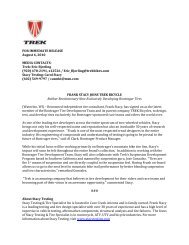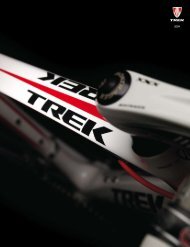Airfoil Development for the Trek Speed Concept ... - Slowtwitch.com
Airfoil Development for the Trek Speed Concept ... - Slowtwitch.com
Airfoil Development for the Trek Speed Concept ... - Slowtwitch.com
You also want an ePaper? Increase the reach of your titles
YUMPU automatically turns print PDFs into web optimized ePapers that Google loves.
Introduction<br />
<strong>Trek</strong> is dedicated to better products through genuine scientific research and innovation. True to this philosophy, <strong>the</strong> <strong>Speed</strong> <strong>Concept</strong>’s<br />
aerodynamics was developed from <strong>the</strong> ground up, using a fundamental scientific approach. This paper tells <strong>the</strong> story of <strong>the</strong> <strong>Speed</strong><br />
<strong>Concept</strong>’s aerodynamic development, focusing on <strong>the</strong> patent-pending breakthrough airfoil technology – <strong>the</strong> Kammtail Virtual Foil (KVF).<br />
To support this story, <strong>the</strong> Appendix includes additional studies, data, and discussions on general topics in bicycle aerodynamic <strong>the</strong>ory.<br />
1 Bicycle-Specific <strong>Airfoil</strong> <strong>Development</strong><br />
1.1 Why <strong>Airfoil</strong>s?<br />
Simply stated, as <strong>the</strong> bicycle moves <strong>for</strong>ward, air resists <strong>the</strong> motion of <strong>the</strong> frame tubes, resulting in aerodynamic drag. The amount of<br />
aerodynamic drag on a given tube is primarily determined by <strong>the</strong> tube’s cross-section. There<strong>for</strong>e, triathlon bicycle tube cross sections<br />
are designed using low-drag 2D airfoil shapes. Because <strong>the</strong>y are <strong>the</strong> building blocks which determine <strong>the</strong> bicycle’s overall aerodynamic<br />
potential, <strong>the</strong>se cross-sectional airfoil shapes were <strong>the</strong> sole focus of <strong>the</strong> first nine months of <strong>Speed</strong> <strong>Concept</strong> research & development.<br />
Figure 2: The <strong>Speed</strong> <strong>Concept</strong> with <strong>the</strong> 2D airfoil cross-sections of several tubesidentified in red.<br />
Note that <strong>the</strong> airfoil is defined in <strong>the</strong> horizontal direction of <strong>the</strong> wind (waterline plane).<br />
4

















